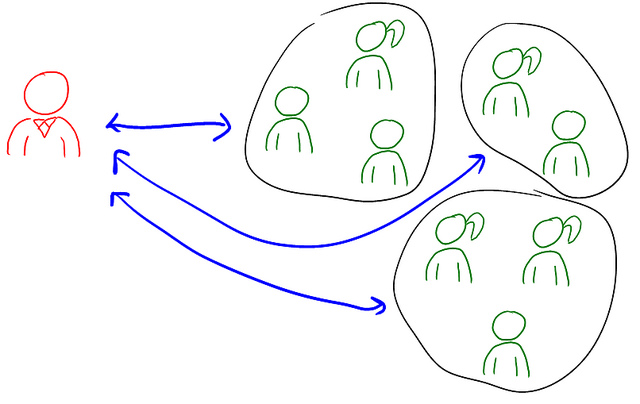1.3: Communication Principles
Learning Objectives
- Discuss how communication is integrated in various aspects of modern life.
- Explain how communication meets physical, instrumental, relational, and identity needs.
- Explain how the notion of a “process” fits into communication.
- Discuss the ways in which communication is guided by culture and context.
Becoming more aware of how you communicate can be informative and have many positive effects in your personal and professional life. Your main purpose in taking this course is, obviously, to enhance your professional communication skills and this is will be our main focus in our course content and assignments. However, personal relationships have much to gain from effective communication, too, as you must be aware and the two categories are not necessarily fully disjunctive. For instance, a friend who is aware of our skills could recommend us for a job, and at work, employees who are well-liked tend to be promoted faster. As we examine several important principles of communication in this section, I encourage you to take note of aspects of communication that you haven’t thought about before and begin to apply the principles of communication to as many parts of your personal and professional life as possible
Communication Is Integrated into All Parts of Our Lives
To facilitate our exploration of the ways in which communication is integrated into all parts of our lives, let us divide our experiential space into four areas: academic, professional, personal, and civic. Of course, there is significant overlap between these areas. For instance, many of your classroom experiences directly correlate to workplace situations, and the classroom has long been seen as a place to prepare students to become active and responsible citizens in their civic lives. The philosophy behind this approach is called integrative learning, which encourages students to reflect on how the content they are learning connects to their other classes they have taken or are taking, their professional goals, and their civic responsibilities.
1. Academic

Improving your communication skills by studying the content presented here can help you maximize your grades in this class and there are other academic advantages of achieving this.
- Better communicators typically prepare better written documents and presentations in other courses.
- As better communicators, you will likely be able to enhance your relationships with colleagues and professors — that is, to network more effectively while in school. This may lead to employment opportunities or opportunities for advancement in the future.
- Students who take communication courses typically have higher grade point averages and are less likely to drop out of school. This significant correlation is one of the main reasons that most college and university programs make taking at least one communication course a requirement for graduation.
2. Professional
The National Association of Colleges and Employers has found that employers most desire good communication skills in the college graduates they may hire (National Association of Colleges and Employers, 2010, p. 25). Countless studies and articles published since confirm this, as do the focus group meetings organized each year at Fanshawe College (see the Introduction to this textbook for more information on the latter). Desired communication skills vary from career to career and this textbook provides a foundation onto which you can build communication skills specific to your industry/field.
Employers appreciate good listening skills and the ability to communicate concisely because efficiency and clarity are often directly tied to productivity and success in terms of profit or task/project completion. In our competitive job market, being able to document that you have received advanced communication instruction and training from communication professionals can give you the edge needed to stand out from other applicants or employees.
Examples
Other articles on employers’ view of communication skills
- Brower, Tracy. (2020, Mar. 16). Communication is more important now than ever before: 9 tips for communication that reassures and reengages people. Forbes. Retrieved from https://www.forbes.com/sites/tracybrower/2020/03/16/the-coronavirus-makes-communication-more-important-than-ever-9-tips-for-communication-that-reassures-and-reengages-people/?sh=5b3e4d38140c
- Kohut, T. (2015, Aug. 26). New study reveals top 10 skills Canadian employers are looking for. Global News. Retrieved from http://globalnews.ca/news/2187705/new-study-reveals-top-10-skills-canadian-employers-are-looking-for/
- Lewington, J. (2014, Aug. 26). Recruiters put premium on communication skills. The Globe and Mail. Retrieved from http://www.theglobeandmail.com/report-on-business/careers/career-advice/recruiters-put-premium-on-communication-skills/article20206416/#dashboard/follows/
- Strauss, V. (2017, Dec. 20). The surprising thing Google learned about its employees — and what it means for today’s students. The Washington Post. Retrieved from https://www.washingtonpost.com/news/answer-sheet/wp/2017/12/20/the-surprising-thing-google-learned-about-its-employees-and-what-it-means-for-todays-students/
3. Personal
While many students know, from personal experience and from the prevalence of communication counseling on television talk shows and in self-help books, that communication forms, maintains, and ends our interpersonal relationships, they do not know the extent to which that occurs. They may lack the tools to examine that phenomenon analytically and to make sure they apply what they discover to future interactions.
Those tools can be acquired by developing a foundational knowledge of communication concepts and theories, so we can master the vocabulary needed to name the communication phenomena we experience, to then note their prevalence, and to take a systematic approach to improving them. This is, again, part of engaging in metacognitive learning which is an approach to these phenomena that increases our ability to consciously alter our communication to achieve our goals, avoid miscommunication, and analyze and learn from our inevitable mistakes. Once we get further into our course content, the personal implications of advanced communication strategies and techniques will become increasingly clear.
4. Civic

Civic engagement refers to working to make a difference in our communities by improving the quality of life of community members, by raising awareness about social, cultural, or political issues or by participating in a wide variety of political and nonpolitical processes (Ehrlich, 2000, vi). The civic part of our lives is developed through engagement with the decision making that goes on in our society at the small-group, local, state, regional, national, or international levels. Such involvement ranges from serving on a neighborhood advisory board to sending an e-mail to our MP, to the Premier of our province, or to the Prime Minister. Discussions and decisions that affect our communities happen around us all the time, but it takes time and effort to become a part of that process. Doing so, however, allows us to become a part of groups or causes that are meaningful to us, which enables us to work for the common good. This type of civic engagement is crucial to the functioning of a democratic society.
Although younger people have tended not to be as politically engaged in terms of voting as other age groups, the current generation of sixteen to twenty-nine-year-olds, known as the millennial generation, is known to be very engaged in volunteerism and community service. In addition, some research has indicated that college students are eager for civic engagement but do not always find the resources they need on their campuses (Jaschik, 2012). The American Association of Colleges and Universities has launched several initiatives and compiled many resources for students and faculty regarding civic engagement. Whether you are part of the millennial generation or you are over thirty, I encourage you to explore their website and try to identify some ways in which you can productively integrate what you are learning in this class into a civic context.
Communication Meets Needs
As this discussion shows, communication is far more than the transmission of information — it can also help us achieve certain physical and instrumental needs while also also feeding into our identities and relationships in complex ways. How does that work?
1. Physical Needs
Physical needs include needs that keep our bodies and minds functioning; communication has substantial effects on our physical body and well-being:
- At the most basic level, communication can alert others that our physical needs are not being met (e.g., babies cry when they are hungry or sick to alert their caregiver of these physical needs; we might ask our friends if we can stay at their house if something happens and our former residence can no longer meet our physical needs for shelter).
- There are strong ties between the social function of communication and our physical and psychological health. Human beings are social creatures, which makes communication important for our survival. In fact, prolonged isolation has been shown to severely damage a human (Williams & Zadro, 2001). The social isolation rules we all had to follow as a consequence of the Covid-19 pandemic have made this need for communication much more obvious.
- People with good interpersonal communication skills are better able to adapt to stress and have less depression and anxiety (Hargie, 2011, p. 2).
- Communication can also be therapeutic, which can lessen or prevent physical problems. A research study found that spouses of suicide or accidental death victims who did not communicate about the death with their friends were more likely to have health problems such as weight change and headaches than those who did talk with friends (Greene, Derlega, & Mathews, 2006, p. 421).
Satisfying physical needs is essential for our physical functioning and survival. But, in order to socially function and thrive, we must also meet instrumental, relational, and identity needs.
2. Instrumental Needs

Instrumental needs include needs that help us get things done in our day-to-day lives and achieve short- and long-term goals. Common instrumental needs include influencing others, getting information we need, or getting support (Burleson, Metts, & Kirch, 2000, p. 247).
To meet instrumental needs, we often use communication strategically. Politicians, parents, bosses, and friends use communication to influence others in order to accomplish goals and meet needs. There is a research area within communication that examines compliance-gaining communication, or communication aimed at getting people to do something or act in a particular way (Gass & Seiter, 1999, p. 205). Compliance gaining and communicating for instrumental needs is different from coercion, which forces or manipulates people into doing what you want. Open communication, free from constraint and pressure, is an important part of an ethical society. Compliance-gaining communication is different from persuasion, however. While research on persuasion typically focuses on public speaking and how a speaker persuades a group, compliance-gaining research focuses on our daily interpersonal interactions. Researchers have identified many tactics that people typically use in compliance-gaining communication (Gass & Seiter, 1999, p. 205). As you read through the following list, I am sure many of these tactics will be familiar to you.
Common Tactics Used for Compliance Gaining
- Offering rewards. Seeks compliance in a positive way by promising returns, rewards, or generally positive outcomes.
- Threatening punishment. Seeks compliance in a negative way by threatening negative consequences such as loss of privileges, grounding, or legal action.
- Using expertise. Seeks compliance by implying that one person “knows better” than the other based on experience, age, education, or intelligence.
- Liking. Seeks compliance by acting friendly and helpful to get the other person into a good mood before asking them to do something.
- Debt. Seeks compliance by calling in past favors and indicating that one person “owes” the other.
- Altruism. Seeks compliance by claiming that one person only wants “what is best” for the other and he or she is looking out for the other person’s “best interests.”
- Esteem. Seeks compliance by claiming that other people will think more highly of the person if they comply or thinks less of the person if they do not comply.
3. Relational Needs
Relational needs include needs that help us build, maintain, and (if needed) end social bonds and interpersonal relationships:
- To develop a relationship, we may use nonverbal communication to assess whether someone is interested in talking to us or not, then use verbal communication to strike up a conversation.
- Next, through the mutual process of self-disclosure, a relationship forms over time.
- Once relationships form, they need to be maintain through positive communication and behaviors that communicate our investment in the relationship (spending time together, frequent engagement through texts, celebrating accomplishments, etc.).
- Finally, communication or the lack of it helps us end relationships. We may communicate our deteriorating commitment to a relationship by avoiding communication with others, verbally criticizing them, or explicitly ending a relationship.
Communicating for relational needs isn’t always positive, though. Some people’s “relational needs” are negative, unethical, or even illegal. Although we may feel the “need” to be passive aggressive or controlling, these communicative patterns are not positive and can hurt our relationships.
4. Identity Needs
Identity needs include our need to present ourselves to others and be thought of in particular and desired ways. What adjectives would you use to describe yourself? Are you funny, smart, loyal, or quirky? Your answer isn’t just based on who you think you are as much of how we think of ourselves is based on our communication with other people.
Just as many companies, celebrities, and politicians create a public image, we desire to present different faces in different contexts. Goffman compared self-presentation to a performance and suggested we all perform different roles in different contexts (Goffman, 1959). Indeed, competent communicators can successfully manage how others perceive them by adapting to situations and contexts. A parent may perform the role of stern head of household, supportive shoulder to cry on, or hip and culturally aware friend based on the situation they are in with their child. A newly hired employee may initially perform the role of motivated and agreeable coworker but later perform more leadership behaviors after being promoted.
Communication Is a Process
Communication is a process that involves an interchange of verbal and/or nonverbal messages within a continuous and dynamic sequence of events (Hargie, 2011, p. 2). When we refer to communication as a process, we imply that it doesn’t have a distinct beginning and end or follow a predetermined sequence of events.
It can be difficult to trace the origin of a communication encounter, since communication doesn’t always follow a neat and discernible format, which makes studying communication interactions or phenomena difficult. Any time we pull one part of the process out for study or closer examination, we artificially “freeze” the process in order to examine it, which is not something that is possible when communicating in real life. Sometimes scholars want to isolate a particular stage in the process in order to gain insight by studying, for example, feedback or eye contact. Doing that changes the very process itself, and by the time you have examined a particular stage or component of the process, the entire process may have changed. However, these snapshots are useful for scholarly interrogation of the communication process, and they can also help us evaluate our own communication practices, troubleshoot a problematic encounter we had, or slow things down to account for various contexts before we engage in communication (Dance & Larson, 1976, 28).
We have already learned, in the transaction model of communication, that we communicate using multiple channels and send and receive messages simultaneously. There are also messages and other stimuli around us that we never actually perceive because we can only attend to so much information at one time. The dynamic nature of communication allows us to examine some principles of communication that are related to its processual nature. Next, we will learn that communication messages vary in terms of their level of conscious thought and intention, that communication is irreversible, and that communication is unrepeatable.

Intention. Some scholars have put forth definitions of communication stating that messages must be intended for others to perceive them in order for a message to “count” as communication. This narrow definition only includes messages that are tailored or at least targeted to a particular person or group and excludes any communication that is involuntary (Dance & Larson, 1976, 28). Involuntary intention may occur when we “read into” involuntary gestures others might make, or mistake intrapersonal communication as being always intentionally; communication occurs in both instances, yet not always intentionally.
Degree of conscious thought. Communication messages also vary in terms of the amount of conscious thought that goes into their creation. In general, we can say that intentional communication usually includes more conscious thought and unintentional communication usually includes less. For example, some communication is reactionary and almost completely involuntary. We often scream when we are frightened, say “ouch!” when we stub our toe, and stare blankly when we are bored. This isn’t the richest type of communication, but it is communication. Some of our interactions are slightly more substantial and include more conscious thought but are still very routine. For example, we say “excuse me” when we need to get past someone, say “thank you” when someone holds the door for us, or say “what’s up?” to our neighbor we pass every day in the hall.
While these types of communication just discussed are common, the messages most studied by communication scholars and the messages this course focuses on the most, are considered constructed communication. These messages include more conscious thought and often go beyond information exchange to meet relational and identity needs. As we will learn later, a higher degree of conscious thought and intention doesn’t necessarily mean the communication will be effective, understood, or ethical. In addition, ethical communicators cannot avoid responsibility for the effects of what they say by claiming they didn’t “intend” for their communication to cause an undesired effect. Communication has short- and long-term effects, which illustrates the next principle we will discuss—communication is irreversible.
The irreversible character of communication. The dynamic nature of the communication process also means that communication is irreversible. Once an initial interaction has gone wrong, it is impossible to turn the clock back and “redo” it. Miscommunication can occur regardless of the degree of conscious thought and intention put into a message. For example, if David tells a joke that offends his coworker Beth, then he can’t just say, “Oh, forget I said that,” or “I didn’t intend for it to be offensive.” The message has been sent and it can’t be taken back.
The unrepeatable character of communication. We have already learned the influence that contexts have on communication. Contexts change quickly and frequently — so, even if our words and actions stay the same between Situation A and Situation B, the physical, psychological, social, relational, and cultural contexts will vary and ultimately change the communication encounter. For instance, if you try to recreate a good job interview experience by asking the same questions and telling the same stories about yourself, you can’t expect the same results. Have you ever tried to recount a funny or interesting experience to a friend who doesn’t really seem that impressed? These “I guess you had to be there” moments illustrate the fact that communication is unrepeatable.
Communication Is Guided by Culture and Context
Western culture tends to put more value on senders than receivers and on the content rather the context of a message. These cultural values are reflected in our definitions and models of communication. As we will learn in later chapters, cultures vary in terms of having a more individualistic or more collectivistic cultural orientation. Canada is considered an individualistic culture, where emphasis is put on individual expression and success. Japan is considered a collectivistic culture, where emphasis is put on group cohesion and harmony. These are strong cultural values that are embedded in how we learn to communicate. In many collectivistic cultures, there is more emphasis placed on silence and nonverbal context.
Whether in Canada, Japan, or another country, people are socialized from birth to communication in culturally specific ways that vary by context. In this section, we will discuss how communication is learned, the rules and norms that influence how we communicate, and the ethical implications of communication.
1. Communication Is Learned
Communication patterns are relative to the context and culture in which one is communicating, and many cultures have distinct languages consisting of symbols, all of which are learnt (from caregivers, starting in infancy, and then through school, social interactions, work experiences, etc.).
Communication is symbolic — that is, the words that make up our language systems do not directly and inherently correspond to something in reality; they point to something that is part of our reality as a matter of convention.
- The existence of different languages is obvious proof of this. For instance, “fish” translates into French as “poisson.” The words are not similar, and neither has any inherent relation to what we think of as fish. We know what the word refers to if we know the language.
- We also speak different “languages” based on the situation we are in. For example, in some cultures, it is considered inappropriate to talk about family or health issues in public, while in others it’s common to do so. At another level, an astronomer and someone who does not specialize in the field would connect the word “star” to pools of knowledge of very different dimensions and levels of depth — and many words used by astronomers might be entirely unknown to most people. Finally, close friends often have their own inside terminology and expressions that would not make sense to anyone else.
2. Rules and Norms
As discussed earlier, whether verbal or nonverbal, mediated or interpersonal, our communication is guided by rules and norms.
Phatic communion is an instructive example of how we communicate under the influence of rules and norms (Senft, 2009). Phatic communion refers to scripted and routine verbal interactions that are intended to establish social bonds rather than to exchange meaning.
Here’s an example:
When you pass your professor in the hall, the exchange may go as follows:
Student: “Hello, how are you?”
Professor: “Fine, how are you?”
Student: “Fine, thank you.”
What is the point of this interaction? It surely isn’t to actually inquire as to each other’s well-being. We have similar phatic interactions when we make comments on the weather or the fact that it’s Monday. We often joke about phatic communion because we see that is pointless, at least on the surface.
The student and professor might as well just pass each other in the hall and say the following to each other:
Student: “Generic greeting question.”
Professor: “Generic greeting response and question.”
Student: “Generic response.”
This is an example of communication messages that don’t really require a high level of conscious thought or convey much actual content or generate much meaning. So if phatic communion is so “pointless,” why do we do it?

The term phatic communion derives from the Greek word phatos, which means “spoken,” and the word communion, which means “connection or bond.” These exchanges are common in North American communication contexts and serve strictly to confirm a connection. Everyone knows not to start discussing specific personal or professional issues when someone asks, “How are you?” and not to go through his/her “to do” list when someone asks, “What’s up?” Instead, we conform to social norms through routine verbal exchanges.
Phatic communion, like most aspects of communication we will learn about, is culturally relative. While most cultures engage in phatic communion, the topics of and occasions for phatic communion vary. Scripts for greetings in Canada are common, but scripts for leaving may be more common in other cultures. Asking about someone’s well-being may be acceptable phatic communion in one culture, and asking about the health of someone’s family may be more common in another.
Communication Has Ethical Implications
Communication ethics deals with the process of negotiating and reflecting on our actions and communication regarding what we believe to be right and wrong.
Communication has broad ethical implications. Later in this book, we will discuss the importance of ethical listening, how to avoid plagiarism, how to present evidence ethically, and how to apply ethical standards to mass media and social media. These are just a few examples of how communication and ethics will be discussed in this book, but hopefully, you can already see that communication ethics is integrated into academic, professional, personal, and civic contexts.

While many behaviors can be more easily labelled as ethical or unethical, communication acts are not always easy to judge. Physically hurting someone is generally thought of as unethical and illegal, but many instances of hurtful speech, or even what some would consider hate speech, have been protected as free speech. This reveals a complicated relationship between protected speech, ethical speech, and the law. In some cases, people see it as their ethical duty to communicate information that they feel is in the public’s best interest. The people behind WikiLeaks, for example, have released thousands of classified documents related to wars, intelligence gathering, and diplomatic communication. WikiLeaks claims that exposing this information keeps politicians and leaders accountable and keeps the public informed, but government officials claim the release of the information should be considered a criminal act. Both parties consider the other’s communication unethical and their own communication ethical. Who is right?
Since many of the choices we make when it comes to ethics are situational, contextual, and personal, various professional fields have developed codes of ethics to help guide members through areas that might otherwise seem uncertain. Doctors take oaths to do no harm to their patients, and journalists follow ethical guidelines that promote objectivity and provide for the protection of sources. Although businesses and corporations have gotten much attention for high-profile cases of unethical behavior, business ethics has become an important part of the curriculum in many business schools, and more companies are adopting ethical guidelines for their employees. The following “Getting Critical” box includes information about the National Communication Association’s Ethical Credo and the International Association of Business Communicators’ Code of Ethics.
 Spotlight: “Getting Critical”
Spotlight: “Getting Critical”
We all have to consider and sometimes struggle with questions of right and wrong. Since communication is central to the creation of our relationships and communities, ethical communication should be a priority of every person who wants to make a positive contribution to society.
The National Communication Association’s “Credo for Ethical Communication” reminds us that communication ethics are relevant across contexts and apply to every channel of communication, including media, and that human worth and dignity are fostered through ethical communication practices such as truthfulness, fairness, integrity, and respect for self and others (National Communication Association, 2012). The emphasis in the credo and in the study of communication ethics is on practices and actions rather than thoughts and philosophies. Many people claim high ethical standards but do not live up to them in practice. While the credo advocates for, endorses, and promotes certain ideals, it is up to each one of us to put them into practice. The following are some of the principles stated in the credo:
- We endorse freedom of expression, diversity of perspective, and tolerance of dissent to achieve the informed and responsible decision making fundamental to civil society.
- We condemn communication that degrades individuals and humanity through the expression of intolerance and hatred.
- We are committed to the courageous expression of personal convictions in pursuit of fairness and justice.
- We accept responsibility for the short- and long-term consequences of our own communication and expect the same of others.
- What are some examples of unethical communication that you have witnessed?
- Read through the whole credo. Of the nine principles listed, which do you think is most important and why?
Let us also examine the principles promoted by the International Association of Business Communicators through their Code of Ethics:
- I am honest. My actions bring respect for and trust in the communication profession.
- I communicate accurate information and promptly correct any errors.
- I obey laws and public policies; if I violate any law or public policy, I act promptly to correct the situation.
- I protect confidential information while acting within the law.
- I support the ideals of free speech, freedom of assembly, and access to an open marketplace of ideas.
- I am sensitive to others’ cultural values and beliefs.
- I give credit to others for their work and cite my sources.
- I do not use confidential information for personal benefit.
- I do not represent conflicting or competing interests without full disclosure and the written consent of those involved.
- I do not accept undisclosed gifts or payments for professional services from anyone other than a client or employer.
- I do not guarantee results that are beyond my power to deliver
You can find this code and read more about this association at this link: https://www.iabc.com/about-us/purpose/code-of-ethics/
In upcoming chapters, we will link these principles of ethical communication to essential requirements of workplace communication such as clarity, cultural sensitivity, objectivity, accuracy in citing sources, honesty in describing our contribution, etc.
Key Takeaways
- Increasing your knowledge of communication and improving your communication skills can positively affect your academic, professional, personal, and civic lives.
- In terms of academics, research shows that students who study communication and improve their communication skills are less likely to drop out of school and are more likely to have high grade point averages.
- Professionally, employers desire employees with good communication skills, and employees who have good listening skills are more likely to get promoted.
- Personally, communication skills help us maintain satisfying relationships.
- Communication intensifies our civic engagement and allows us to participate in and contribute to our communities.
- Communication meets our physical needs by helping us maintain physical and psychological well-being; our instrumental needs by helping us achieve short- and long-term goals; our relational needs by helping us initiate, maintain, and terminate relationships; and our identity needs by allowing us to present ourselves to others in particular ways.
- Communication is a process that includes messages that vary in terms of conscious thought and intention. Communication is also irreversible and unrepeatable.
- Communication is guided by culture and context.
- We learn to communicate using systems that vary based on culture and language.
- Rules and norms influence the routines and rituals within our communication.
- Communication ethics vary by culture and context and involve the negotiation of and reflection on our actions regarding what we think is right and wrong.
Exercises
- Getting integrated: The concepts of integrative learning and communication ethics are introduced in this section. How do you see communication ethics playing a role in academic, professional, personal, and civic aspects of your life?
- Identify some physical, instrumental, relational, and identity needs that communication helps you meet in a given day.
- We learned in this section that communication is irreversible and unrepeatable. Identify a situation in which you wished you could reverse communication. Identify a situation in which you wished you could repeat communication. Even though it’s impossible to reverse or repeat communication, what lessons can be learned from these two situations you identified that you can apply to future communication?
- In what types of phatic communion do you engage? How are they connected to context and/or social rules and norms?
References
Burleson, B. R., Metts, S. and Kirch, M.W. (2000) Communication in close relationships. In C. Hendrick and S. S. Hendrick (Eds.), Close Relationships: A Sourcebook (245-57). Sage.
Dance, F. E. X., & Larson, C. E. (1976). The functions of human communication: A theoretical approach. Holt, Rinehart and Winston.
Ehrlich, T. (2000). Civic responsibility and higher education. Oryx, 2000).
Gass, R. H., and Seiter, J.S. (1999). Persuasion, social influence and compliance gaining. Allyn and Bacon.
Goffman, E. (1959). The presentation of self in everyday life. Anchor Books
Greene, K., Derlega, V.D. and Mathews, A. (2006). Self-disclosure in personal relationships. In A. L. Vangelisti & D. Perlman (Eds.), The Cambridge handbook of personal relationships (pp. 409–427). Cambridge University Press. https://doi.org/10.1017/CBO9780511606632.023
Hargie, O. (2011). Skilled interpersonal interaction: Research, theory, and practice. Routledge.
Jaschik, S. (2009, Sept. 30). The civic engagement gap. Inside Higher Ed, http://www.insidehighered.com/news/2009/09/30/civic.
National Association of Colleges and Employers. (2010). Job outlook 2011.
Senft, G. (2009). “Phatic communion. In G. Senft, J.-O. Ostman, & J. Verschueren (Eds.), Culture and angluage use (pp. 226-33). John Benjamins Publishing Company.
Williams, K. D., and Zadro, L. (2001). Ostracism: On being ignored, excluded, and rejected. In M. Leary (Ed.), Interpersonal rejection (pp. 21–54). Oxford University Press
Zabava, W. S., & Wolvin, A.D. The differential impact of a basic communication course on perceived communication competencies in class, cork, and social sontexts. Communication Education 42 (1993), 215–17.

